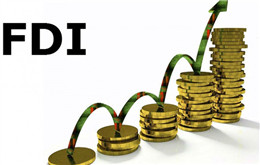The day before, the person in charge of the Foreign Department of the Ministry of Commerce said that the amount of
foreign-invested enterprises (FIEs) in China increased sharply in September, the increase was 17.3 percent. In the first nine months of this year, foreign investment in high-tech manufacturing and high-tech services grew faster, with year-on-year growth of 27.5% and 24% respectively.

Data from the Ministry of Commerce show that in the first nine months of this year, the number of foreign-invested enterprises in China was 23541, up 10.6% year on year. Its actual use of foreign capital was 618.57 billion yuan, up 1.6 percent year on year. In September, 3152 new foreign-invested enterprises were established in China, up 14.5% from the same period last year. Its actual use of foreign capital was RMB 70630 million, up 17.3% year on year.
According to Ye Wei, Deputy Director of the Foreign Capital Department of the Ministry of Commerce, the main features of China's FDA absorption in the first nine months of this year: first, the actual use of foreign capital increased in September. The second was the resumption of foreign investment in manufacturing in the first nine months of this year. In the first nine months of this year, the actual use of foreign investment reached 181.76 billion yuan, up 7.5% year on year, accounting for 29.4% of the total foreign investment. High technology manufacturing and high-tech services industry maintained strong growth momentum.
In the first nine months of this year, the actual use of foreign investment in high-tech manufacturing was 529.8 billion yuan, up 27.5% year-on-year. The actual use of foreign investment in high-tech services was 91.59 billion yuan, up 24 percent year on year. Third, the absorption of foreign capital in the central region has continued to grow rapidly. In the first nine months of this year, the actual use of foreign investment reached 45.63 billion yuan, up 46% year-on-year. In addition, in the major sources of investment, China's Hong Kong and Taiwan regions, Japan, France and other economies are growing rapidly.
It is understood that China has stepped up its efforts to attract foreign investment this year. The State Council released documents in January and August, with 42 measures to boost foreign investment. According to Ye Wei, Deputy Director of the Foreign Capital Department of the Ministry of Commerce, the actual use of foreign capital in September proved that these measures are beginning to show results. "The first is that the Central Committee of the CPC attaches great importance to it and has held a number of thematic conferences and studies since this year. The State Council also issued 5 documents and 39 documents, and proposed 42 measures to promote foreign investment. And relevant measures have been implemented successively, increasing the confidence of foreign investors. The second aspect is the acceleration of industrial structure upgrading, which has brought market opportunities to foreign investors and promoted the continuous growth of foreign investment in high-tech fields. The high technology services industry has been able to absorb foreign capital for four consecutive months. The third is the big project, since September, more than $100 million of large-scale projects such as Foxconn in Zhengzhou and Corp of Hong Kong in Nanjing, which directly led to the increase of foreign investment in the month.
Just a month ago, the State Council issued a notice on measures to promote the growth of foreign investment. It made clear that it would introduce an open road map and timetable for 12 areas, including new energy vehicle manufacturing, ship design, banking, securities industry and insurance industry. The negative list that has been tried in the pilot zone will also be promoted nationwide as soon as possible.
According to the Ministry of Commerce, more than 50 departments and more than 20 provincial governments have put forward the implementation plan. The Ministry of Commerce has changed from "case-by-case" to "online filing" in foreign mergers and acquisitions that did not involve special administrative measures in August. At the local level, there is a new wave of open-up. This year, China has launched a new policy of opening up and actively utilizing foreign capital, including Zhejiang, Hubei, Jiangsu and Fujian.
According to the introduction, since the 18th CPC National Congress, China has accelerated the construction of the new system of open economy, and strive to create a more attractive international, rule of law, convenient business environment, foster new advantages to enhance international competition. It has introduced a series of policy measures to expand access to foreign capital markets and has achieved positive results. First, we should accelerate the construction of a
free trade zone and make open doors bigger and bigger. The second is to revise the catalogue of foreign investment industry guidance, and further reducing restrictive measures. The third is to ease the market access threshold for the service sector and manufacturing industry and give foreign investment greater scope in China. At present, the opening level of China's service industry, manufacturing industry and mining industry has been greatly improved, and the general manufacturing industry has been basically released.
Ye Wei said that the next step will continue to promote the expansion of opening-up and deepening reform, and build a free trade zone in a high level, and build a good national economy, such as the open zone, etc., then we will optimize the business environment and enhance the competitiveness of attracting foreign investment.


